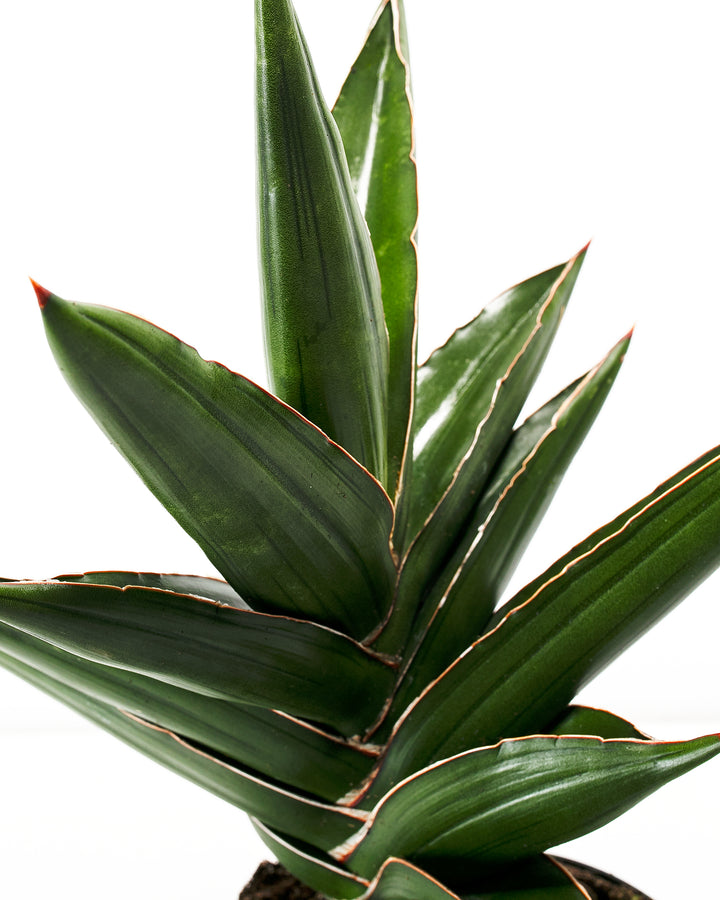Gift Card Balance
Enter the code below to redeem your gift card

A unique, rare snake plant, the miniature Sansevieria Samurai (Sansevieria ehrenbergii ‘Samurai’) is a compact plant with thick, dark green, sword-shaped leaves, edged in white. It belongs to the Asparagaceae family and is also known as Dracaena hanningtonii since snake plants have recently been reclassified into the Dracaena genus of plants.
Native to West Africa, the Samurai Snake plant is drought-tolerant and thrives in bright, indirect light. This charming dwarf cultivar of the snake plant grows to only about 6-7 inches in height. Suitable for growing outdoors in hardiness zones 10-11, its miniature size makes it more popular as an indoor plant. Durable and easy-care houseplants, snake plants are known to live for over 20 years, requiring little maintenance. Because of the saponins in its leaves, the Samurai Dwarf Snake Plant is toxic to pets when ingested.
Snake plants are associated with good luck in Feng Shui and bring prosperity into a home. The Samurai Sansevieria, also known as the Samurai Dwarf Snake Plant, is a rare variety growing in popularity. Its compactness and rarity make it an exceptional gift for plant lovers.
Other excellent Sansevieria varieties that will make you fall in love include the tall, stately Sansevieria Zeylanica (Sansevieria trifasciata Zeylanica) and the silvery-green Sansevieria Moonshine (Sansevieria trifasciata 'Moonshine').
One of the strongest benefits of snake plant varieties is that they’re super easygoing and won’t take up much of your time. Just follow these easy Sansevieria care tips to keep your plant thriving:
One of the most important things to remember is that your Sansevieria Samurai doesn’t require a lot of water, as it’s a succulent. The Samurai Plant prefers its soil to dry out between waterings, and overwatering can seriously harm this tough plant. It doesn’t need more than average humidity and can adapt to dry air.
Sansevieria Ehrenbergii Samurai Dwarf flourishes in bright, indirect light and prefers warmer temperatures. Although it can adapt to various light and temperature conditions easily, avoid keeping this plant in direct sunlight because it can scorch its leaves. The optimal temperatures for your Snake Plant Samurai are 55°F-85°F. If temperatures drop below 50°F, bring your plant indoors.
Always use a well-draining cacti or succulent potting mix for your Dwarf Sansevieria, since soggy soil can lead to root rot. Repot once in 2-3 years; the Dwarf Samurai prefers to be slightly rootbound. Snake Plants don’t need a lot of fertilizer to thrive. Overfertilizing can cause more harm than good. Feed your plant twice yearly with a balanced liquid fertilizer diluted to half strength.
You can propagate your snake plant by cutting off a leaf, placing it in an inch of water in a tall container, and changing the water regularly until you see roots developing. You can then plant it, supporting its leaves until the roots become more robust. Don’t forget to place young Sansevieria Dwarf plants in an indirect light.
For the best Samurai Snake Plant care, prune off damaged or dead foliage and clean your plant’s leaves with a damp cloth to remove dust.
Soft, drooping, and yellowing leaves are a sure sign of overwatering. Move your plant to a sunnier corner, and don’t water it until the soil gets dry. Crisp brown spots on the leaves can signal underwatering. Brown spots can also be caused by sunburn if your plant gets too much direct sunlight. Move it to a place with a mild, indirect sun and let it recover.
The compact and delightful Sansevieria Samurai Dwarf is a wonderful addition to your home’s plant collection, enhancing the vitality and appeal of your living space.
Group your Snake Plant Samurai with other compact tropical plants to transform your living space into a lush, peaceful oasis:
If you’re a pet owner, here are some beautiful and entirely pet-friendly alternatives to the Dwarf Snake Plant:
Indulge your love for the extraordinary with a stunning miniature Sansevieria Samurai!
Follow us @livelyroot & show us your #livelyroot plants

